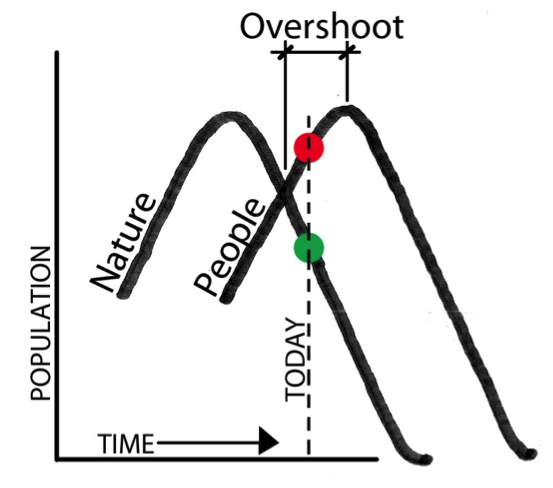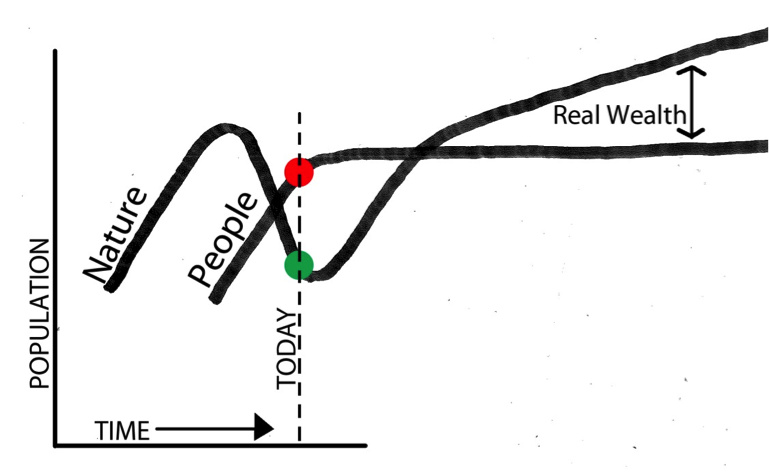By J.D. Alt
 The squiggle illustrated here may look like the Ebola virus, but it isn’t. The resemblance is just an eerie coincidence. It’s actually a graphical snapshot of the classic “Predator-Prey Model.” This mathematical exercise, first developed in the 1920s, serves as the introductory basis for a more recent NASA funded effort which produced—amidst a brief flurry of news and commentary last spring—the startling conclusion that a complete collapse of modern civilization may now be “irreversible.”
The squiggle illustrated here may look like the Ebola virus, but it isn’t. The resemblance is just an eerie coincidence. It’s actually a graphical snapshot of the classic “Predator-Prey Model.” This mathematical exercise, first developed in the 1920s, serves as the introductory basis for a more recent NASA funded effort which produced—amidst a brief flurry of news and commentary last spring—the startling conclusion that a complete collapse of modern civilization may now be “irreversible.”
The NASA study involved the creation and running of a more elaborate model—HANDY (Human and Nature Dynamics)—which simulates the human consumption of naturally replenishing systems, as well as (intriguingly, given today’s news cycle) wealth and income inequality between two classes of citizens: “Elites” and “Commoners.” Now a new study, just released by the World Wildlife Fund, reports a grim statistic suggesting the abstract mathematics of the HANDY Model may be more than just a theoretical exercise. According to the WWF, in the last forty years—from 1970 to 2010—the Earth has lost over HALF (52%) of its wildlife population.

If you graph this wildlife population loss, it looks uncannily similar to the graph-line of “Nature” in the HANDY Model: a point is reached where, suddenly, after a steady rise, or a gradual equilibrium, the graph-line of “Nature’s” population changes direction and begins to plummet. What is startling about the HANDY Model is that when this happens, the human populations of “Elites” and “Commoners” continue to rise, crossing the falling graph-line of “Nature.” This is called “overshoot”—the point where the human population begins consuming “Nature’s” resources faster than “Nature” can replenish them. The human population, after some period of “overshoot,” begins (of necessity) to collapse as well. The population of “Commoners” collapses first because the “Elites” are able, for a period of time, to thrive on their “Wealth.” In some iterations of the model, “Nature” recovers after the “Elite” population finally base-lines; in other iterations “Nature” fails to recover at all—the world becomes simply a wasteland, like one of those planets we keep investigating to see if it ever supported life.
In addition to giving a dose of reality to the graph-lines of the HANDY Model, the WWF study calculates the degree of “overshoot” the human population is currently engaged in: According to the study, at present rates of consumption, human civilization requires 1.5 Earths to meet its needs. The NASA funded scientists were able to get their model to reach equilibrium (avoid collapse) by adjusting variables that significantly reduced consumption, but this proved difficult to achieve without also substantially reducing the inequality of wealth and income between the “Elites” and “Commoners.” Failing more often than not to avoid collapse, the NASA report dryly (and parenthetically) comments on what a suddenly falling graph-line for the human population would actually mean in everyday reality: “There are a variety of mechanisms which can reduce population when it exceeds carrying capacity, including everything from emigration, increased disease susceptibility and outright starvation, to breakdowns in social order and increased social violence, such as banditry, riots, rebellions, revolutions and wars.” If all that sounds familiar, keep this in mind: assuming we’re presently in the middle of our “overshoot,” we haven’t even gotten there yet.
It seems to me this poses a dilemma for the field of economics. As Keynes says (with such sudden clarity in the midst of his densely worded General Theory): “Consumption—to repeat the obvious—is the sole end and object of all economic activity.” How then are we to have “economic growth and prosperity” if we must—as the HANDY Model and WWF study are telling us—cut back our present consumption of natural resources? Modern Monetary Theory makes it clear that a sovereign government can issue fiat dollars to employ its citizens to accomplish virtually anything they’re capable of—so long as the real resources are available to be used. And the point is added that paying the citizens to accomplish these things gives them purchasing power to subsequently produce and consume things in the private economy, which contributes to a general economic prosperity. But now we have the problem that the building of that consumer power will inevitably result in an INCREASE in consumption—exactly the opposite of what we can see is required to avoid the collapse.
The questions that arise, then, are these: Can we create jobs and REDUCE our consumption of nature’s resources at the same time? Is it possible to increase our “standard of living” while consuming less of what nature must regenerate? Can we create world-wide full employment at a living wage without bringing on the collapse of the natural systems we’re embedded in and feeding on? And, finally, what is the meaning of “wealth” itself if we must reduce consumption rather than increase it?
This may sound like the old song “sustainability” that’s been played so many times now, for so many years, it’s gotten worn out. The reason I think it’s worn out, however, is because it was never properly composed in the first place. What the worn-out version of “sustainability” gave us to pursue was simply a continuation of what Keynes refers to as our “propensity to consume”—but doing it now “sustainably” with different energy sources and a new palette of materials. Thus we’ll drive electric cars, but we’ll still aspire to having two or even three of them in every driveway. We’ll continue stringing our housing communities all over the countryside with roads and freeways, but we’ll build the houses with wood from “managed” forests. We’ll generate our electricity with wind turbines, but we’ll still aspire to owning every electrical appliance that can be invented. If this idea of “sustainability” has produced what the WWF study is reporting, then it’s clearly an idea that’s not accomplishing what’s needed.
What has to be adjusted is not just our energy sources and building materials, but our “propensity of consume” itself. It’s important to note this does not mean we must reduce consumption in general, or even in aggregate. We need only reduce consumption with regard to non-renewable stocks and regenerative natural systems. There are many other kinds of consumption which can be increased (and even increased a great deal.) For example, we could consume a lot more of education, art, leisure, literature, music, craft-work, and care-giving. Wealth is still desirable to maximize the production and consumption of these and other things—and “employment” (human effort) is required to both produce the things themselves and provide the income to consume them.
What we need to imagine, I think, is a new kind of “prosperity”—one that combines a carefully limited consumption of nature’s regenerative resources with a robust consumption of human labor and creativity. And the most important of those creative efforts would be directed toward rebuilding the capacity of nature itself—and devising ways to “live” in that nature (and consume what it produces) without degrading it.
The best example of this I’ve come across is the no-tillage farming techniques developed by Masanobu Fukuoko, a Japanese plant pathologist turned experimental farmer who, before his death, came close to making the world realize that modern agriculture is a natural disaster. While mechanized growing systems have enabled the production and consumption of food on an enormous scale, Fukuoko showed us they have also “consumed” the regenerative capacity of the most important layer of the biosphere: the soil. Beginning with the very act of tilling—which disrupts the subsurface culture of micro-organisms that make the soil “alive”, modern agriculture proceeds to to transform a complex, self-generating, incubator-of-life into a neutral “root medium” which must subsequently be saturated with chemicals to support plant growth. The plants themselves must then be genetically modified to better thrive in the chemical stew of the root medium that used to be soil.
What Fukuoko demonstrated was that it is possible to achieve “modern” yields of rice (and other grains and vegetables) without ever tilling the soil, flooding it with excessive irrigation, or administering it with chemical fertilizers, weed-killers, or pesticides of any kind. His techniques of food-growing eliminate the consumption of (a) fossil fuels for tractors, (b) steel and rubber for the tractors themselves, (c) chemical fertilizers, (d) chemical weed-killers and pesticides, and (e) excess irrigation. Most important, however, his methods actually replenish and increase the regenerative capability of the soil itself. Fukuoko’s agriculture also requires something that modern agribusiness has done its level best to eliminate: Farmers. Nor is Fukuoko’s farmer a back-breaking, toiling peasant: he is a philosopher who can sleep late if he wants, and who spends much of his time cooking fresh, seasonal food and entertaining visitors. That sounds like “prosperity” to me.
Three years ago I finished a novel (The Architect Who Couldn’t Sing) and put the following tag-line on the cover: “It’s too late now to save wild nature. What we can do, if we’re lucky, is give it room to save us.” At the time it seemed an appropriate intimation of the story. Now I think I’m beginning to see what it actually means. The HANDY graph we need to create is this:













Pingback: J.D. Alt: Have We Passed the Tipping Point of Biological Collapse? | naked capitalism